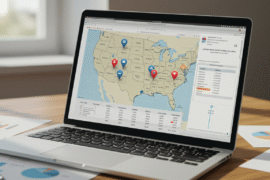This article may contain references to products or services from one or more of our advertisers or partners. We may receive compensation when you click on links to those products or services. Nonetheless, our opinions are our own.
The information presented in this article is accurate to the best of our knowledge at the time of publication. However, information is subject to change, and no guarantees are made about the continued accuracy or completeness of this content after its publication date.
Key Highlights
- Find out the tools and steps you need to easily build a Shopify store. You can do this even if you are a beginner with no experience.
- Learn why design, templates, apps, and storefronts are important in making your online shop appealing and useful.
- Check out a simple guide on how to set up a Shopify store. This includes getting a domain name and improving your presence for Facebook ads.
- Discover how Udemy courses can help you gain key skills for e-commerce. This covers SEO, dropshipping, and web design, all of which can boost your online sales.
- Learn about common mistakes to avoid while setting up your Shopify store and ways to make it perform better.
- Get useful tips on digital marketing to help turn your Shopify store into a successful business.
Introduction
Are you trying to improve your Shopify store? The world of online shopping is growing quickly, and Shopify is a popular choice for turning ideas into successful shops. New entrepreneurs and seasoned sellers can take courses on Udemy to learn new skills. This can help them build attractive storefronts, increase sales, and develop smart marketing plans. In this guide, you can discover Shopify’s features, get setup tips, and see how learning platforms like Udemy can support you in growing your online shop.
Voted "Best Overall Budgeting App" by Forbes and WSJ
Monarch Money helps you budget, track spending, set goals, and plan your financial future—all in one app.
Get 50% OFF your first year with code MONARCHVIP
Understanding Shopify and Its Ecosystem
Shopify is changing ecommerce. It provides a big platform that lets anyone create an online store easily. You can sell physical items, like jewelry, or digital products, like ebooks. Shopify has tools for all types of businesses. It also helps with services, ticketed events, and managing memberships. This makes it perfect for entrepreneurs in many fields.
The Shopify ecosystem is great for more than just sales. It connects apps and templates to build attractive online stores. With easy navigation and helpful marketing tools, Shopify allows users to make stores that look good and are simple to use. It also makes managing backend tasks easier.
What is Shopify?
Shopify is a strong ecommerce platform. It helps people create an online store to sell products or services on the internet. This platform is good for everyone, from small business owners to big companies. Shopify provides tools to build, manage, and grow your store. It can handle different types of goods, like physical items, digital products, or services, all using a simple and user-friendly interface.
This platform is perfect for your ecommerce needs. You can sell handmade items, dropship special products, or offer digital downloads like courses or audio files. Using Shopify, you can also provide services like consultations or event tickets. It suits many industries, including art and wellness.
The good thing is you don’t need to know coding or have special skills to use Shopify. It is designed to be simple. With basic internet access and some computer skills, anyone can make an online store and connect with people worldwide.
Key components of the Shopify platform
Shopify is a platform designed to help you build and manage your online store easily. Here are some important points that make Shopify stand out:
- Apps: Shopify has many apps to help you manage inventory, email marketing, and product reviews. These apps let users shape their store just the way they like.
- Templates: Shopify provides many templates to help you quickly create a beautiful store.
- Storefronts: The drag-and-drop builder makes it simple to create a nice storefront that catches customers’ eyes.
- Custom Domains: Having your domain improves your store’s trust and helps you build your brand.
- Marketing Tools: Shopify’s tools work with SEO and Facebook ads to bring more visitors to your shop.
These features come together to make Shopify a complete solution. You can build, brand, and grow your online store successfully with Shopify.
Setting Up Your Shopify Store: A Beginner’s Guide
Starting your journey with Shopify is fun, but it can feel a bit challenging. Shopify has a simple platform and useful courses. This way, you can set up a successful online store, even if you are just starting. If you understand the basics, like how to register a domain name and customize templates, you can start your journey with a strong base.
It is very important to have the right tools. For example, Udemy’s courses can help you with key tasks. They show you how to add products, set up SEO, and make your store look better for more sales. Get ready to turn your business idea into reality and engage well with your target audience.
What you’ll need to get started
Starting a Shopify store includes several important steps. First, you have to pick a domain name. This name helps create a unique and easy-to-remember identity for your online store. It should reflect what your brand represents. Next, think about the products or services you want to sell. You can offer anything from handmade items to dropshipped products or even downloadable content.
Having a good business idea is essential. Spend some time looking into your area to find gaps. Understanding what your audience wants will help you be different from others. It will also make marketing easier for you in the future.
Lastly, you need internet access and a computer to use Shopify. These are key tools for starting your business. The good thing is that Shopify is simple to use. This helps beginners with no tech skills to start easily.
Step-by-step guide/process
Setting up a Shopify store is simple. The design is easy to follow. Here’s how to start:
| Step | Description |
|---|---|
| Create a Shopify Account | Sign up with an email and password to access Shopify’s platform. |
| Choose Subscription Plan | Evaluate various subscription levels to select the one that fits your business needs. |
| Pick a Theme | Browse Shopify’s library of templates and select one to design an attractive storefront. |
| Add Products | Upload physical, digital, or dropshipped items alongside optimized descriptions and images. |
| Connect Custom Domain | Register a custom domain to solidify your store’s branding and professional appearance. |
| Use Marketing Features | Apply SEO, and start Facebook ads using Shopify’s built-in marketing tools for better customer outreach. |
The table below is helpful. It guides you on how to build your store step-by-step. It also helps you make your store even better.
Conclusion
In conclusion, using Shopify can boost your online store. It is even better if you take advantage of resources like Udemy courses. Learning about the main features of the platform is very important. A well-set-up store makes shopping easier for your customers. Remember, spending time to learn can lead to more sales and loyal customers. If you want to improve your Shopify skills, think about signing up for a Udemy course today. You will get helpful tips and practical methods for success.
Frequently Asked Questions
What are the key features of Shopify that can enhance my online store’s performance?
Shopify offers many great features to help your online store. You can take advantage of strong SEO tools and dropshipping options. There are also various apps and Facebook marketing tools to use. You can make your storefront more appealing by customizing it with templates. This can help draw more visitors to your site. A well-designed store leads to better traffic and makes it easier to manage your online store.
How can Udemy courses specifically help me improve my Shopify skills?
Udemy’s Shopify masterclasses give you useful tips on web design, SEO, and how to improve your store. These online courses help you learn new skills. You will find out how to create storefronts, update product listings, and use marketing strategies. With this knowledge, you can make a professional and successful Shopify store.
Are there any prerequisites for taking Udemy courses focused on Shopify?
You don’t need special skills to get started. Udemy’s Shopify courses are made for beginners and learners from different backgrounds. All you need is a computer, internet access, and a desire to learn how to set up and grow your Shopify store effectively.
What are some common mistakes to avoid when setting up a Shopify store?
Take your time during the setup process. Don’t skip the important dropshipping basics. If you ignore things like improving templates, picking the right product niches, or using marketing tools, it can hurt your store’s success. Keep up with trends, like the TikTok Shop integration in September. This will help you adapt more easily.

Reviewed and edited by Albert Fang.
See a typo or want to suggest an edit/revision to the content? Use the contact us form to provide feedback.
At FangWallet, we value editorial integrity and open collaboration in curating quality content for readers to enjoy. Much appreciated for the assist.
Did you like our article and find it insightful? We encourage sharing the article link with family and friends to benefit as well - better yet, sharing on social media. Thank you for the support! 🍉
Article Title: Udemy vs. Shopify: How to Take Your Online Store to the Next Level
https://fangwallet.com/2025/05/10/udemy-vs-shopify/The FangWallet Promise
FangWallet is an editorially independent resource - founded on breaking down challenging financial concepts for anyone to understand since 2014. While we adhere to editorial integrity, note that this post may contain references to products from our partners.
The FangWallet promise is always to have your best interest in mind and be transparent and honest about the financial picture.
Become an Insider

Subscribe to get a free daily budget planner printable to help get your money on track!
Make passive money the right way. No spam.
Editorial Disclaimer: The editorial content on this page is not provided by any of the companies mentioned. The opinions expressed here are the author's alone.
The content of this website is for informational purposes only and does not represent investment advice, or an offer or solicitation to buy or sell any security, investment, or product. Investors are encouraged to do their own due diligence, and, if necessary, consult professional advising before making any investment decisions. Investing involves a high degree of risk, and financial losses may occur including the potential loss of principal.
Source Citation References:
+ Inspo
There are no additional citations or references to note for this article at this time.











































